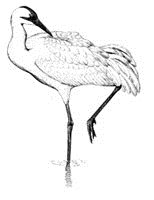North American Crane Working Group

Proceedings of the North American Crane Workshop
Date of this Version
2023
Document Type
Article
Citation
Proceedings of the North American Crane Workshop (2023) 16: 182–194
Abstract
Whooping cranes (Grus americana) have been raised and released into the Eastern Migratory Population (EMP) since 2001. Cranes either were costume-reared and learned their migration route by following an ultralight aircraft, were costume-reared and released in fall near adult cranes (known as direct autumn release), or were parent-reared by captive adult whooping crane pairs and released in the fall near adult whooping cranes. Compared to costume-rearing, parent-rearing encourages conspecific learning prior to release, but needs further research to understand how it may influence post-release behaviors including migration. This study compared the migratory timing and length of parent-reared whooping cranes and ultralight-led, costume-reared whooping cranes in the EMP during 2012–2023. Using GPS data from satellite transmitters, we determined when cranes were migrating or stationary and categorized movements as summering, stopover (2 or more relocations in an area that spanned overnight hours), migratory, or wintering. No differences in timing, distances, or duration of migration were detected during the spring between parent-reared cranes and costume-reared cranes. However, parent-reared cranes migrated shorter distances (W = 65, P = 0.02), migrated shorter durations (W = 61, P = 0.04), and completed migration earlier in the year during the fall (W = 65, P = 0.02). These results were expected given that costume-reared-cranes were taught specific routes with numerous stopovers to Florida during ultralight-led migrations while parent-reared cranes experienced a greater variety of wintering locations and migratory routes from other cranes. Individual cranes from both rearing groups (parent and costume-reared) sometimes followed different migration routes from year to year. These results suggest that rearing and release techniques have some effects on post-release selection of migratory routes but not the timing of migratory initiation. Future work should include comparisons with direct autumn release costume-reared cranes.


Comments
United States government work